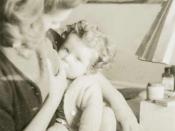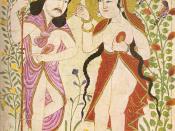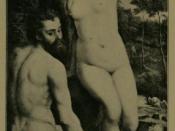James Gleeson - Creation of Eve, 1980 - Task 8
The painting "Creation of Eve" by James Gleeson illustrates what seems to be bones disseminated around the painting. It was influenced by the story of Adam and Eve; particularly the way it was told in Genesis of the Old Testament the way God created Eve, the first women, from one of the ribs of the first man, Adam to be his companion". The quote contributes to the idea of the painting as it symbolises the bones and parts with the creation of Eve.
The composition of the painting was constructed using charcoal, pastel and water colours. Line is used in the painting to define the bones. Visually the texture is matte and uneven. Through the use of browns and whites shaded together, it creates a dull and dusty scenery. The lightness and darkness of the browns and whites contribute to the dullness.
The construction of the bones and where it is positioned; closely together creates balance in the painting. The painting very much creates harmony as the colours combined are similar creating the same dull and dusty feeling. When visualising the painting, it can be seen that the bones are not actually connected but overlapped by each other making the focal point easy to follow with the eye which creates unity.
Gleesons work usually delves in a religious subject matter which is the same in this case. The painting is influenced by the Adam and Eve story told in Genesis.
The way the Creation of Eve was composed using Visual Language creates a dull atmosphere/mood. Although this may be the case, it also gives a feeling of beginning. The dullness gives a feeling as if there is nothing and the puzzled bones which will create Eve, creates beginning.
Victory Girls, 1943 - Task 7 - Albert Tucker
Victory Girls by Albert Tucker is viewed as a strange portrait that illustrates four corpses in a shadowy and mysterious setting. Based on the date stated, 1943, the painting is based during World War 2. During this time Australia was experiencing social change in society regarding women e.g women received the right to vote in Federal and Parliamentary elections. Victory Girls reflect these changes in the women in Australian society by portraying them as more free, more promiscuous (as they are viewed to be half naked). Albert Tucker is very much influenced by the patients he attended to in Heidenburg Military Hospital where he spent most of his time working during WW2. His painting is influenced by the mental illnesses and physical disabilities suffered by the patients as a result of war. This is evident in the painting as it is reflected through the death corpse's demented smiles and sliced noses. These are symbolic meanings of the horror and madness of the war but it also reflects Tucker's social realist, surrealist and expressionistic style. The crescent shaped mouth could be said to be Tucker's trademark, he uses it as it symbolises the idea of modern evil.
Victory Girls reflect the social and political idea of Australia during the 1940s. With the evolving of women in Australian society, they went from modestly dressed with ankle long dresses before the 1910s to the impact of WW1 where they gained freedom in sense of career opportunities and appearances where they explored red lipstick and mascara. These aspects heightened during WW2 where young girls would admire the handsome soldiers. The painting reflects the grasping lust with sexual predatory in these young girls as the soldiers grab them. It is easily understood that the strange corpse holding the girls are soldiers due to their slouched hats and uniform. These events resulted in the loss of innocence in Australian youth.
Politically, the painting may symbolise the feminist movements that was up and running and the prostitution that took place in streets, alleyways and parks.
The colour of the paintings setting is gloomy and emphasises the horror, madness, and post war depression underwent by the soldiers of war. The saturation contributes to the dullness with the use of browns, yellow, mixed blue and purple in the sky and dull greens. The use of black and dark greens on the corpse soldiers, it was created with bold strokes The painting is merely symmetry to each side which creates a sense of balance. The flow of the lines on the corpse's skirt is repetitive in the changes of colour, white, orange and purple and and the lines were constant. These aspects create unity and harmony to the painting. The texture seems uneven and rugged e.g the hair looks coarse.
Fiona Hall - Task 3 - Paradisus Terrestris
The image consists of three small gold aluminium sculptures. Each sculpture represents a different tree; the first sculpture (first to the left) being a Araliya Tree, second (middle) is a Malliya Tree and the last is a Frangipani/Temple Tree found in Sri Lanka. Beneath each tree the routes symbolise a human body part e.g sculpture one has breasts, sculpture 2 has an arm and sculpture three has testicles impressed into the aluminium.
Materials used to construct the sculpture were sardine aluminium cans, gold and metal for the upper part of the tree.
When translated, Paradisus Terrestris, means Paradise on Earth. The sculptures present Halls interest in the human body and sexuality.
Visually, the texture of the three sculptures seems to be smooth (the cans), irregular (body parts impressed into can) and uneven (leaves of the tree). Where the gold bark meets, connecting and creating the curve of the trees, it creates unity in the sculpture. When referring to the title "Paradise on Earth", the colour Gold appears to be a rich resource and by creating the sculptures with gold it gives an elegant appearance.
Jeffrey Smart - Task 6 - Quinces by the Sea
The painting "Quinces by the Sea" illustrates a surreal atmosphere of a beach setting with the sea in the background, a stranded boat on the shore and at the focal point lays eleven quinces. The positioning of the sun may be towards the right as the quinces shadow is towards the left of the painting.
The use of yellows, blues and whites create a warm summary feeling. Visually the texture seems smooth and calm. The use of Lines used to define the quinces and its shape. The sky was shaded using whites and blues making it look more realistic but also makes the sky look gloomy.
Smart's unsentimental paintings encompass lonely urban vistas that seem both disturbing and threatening and this painting reflects that as the image seems isolated and lonely. 'Quinces by the Sea' has no necessary social, cultural or political influences but is more of a contemporary style.
Kathryn Del Barton - "I ate the Rainbow up"
The painting 'I ate the Rainbow up' illustrates two women; one shown as a dominant figure placing her right hand over the second womens eye. The overall painting is balanced and connsists of dots in the background with three black odd looking stars.
A variety of lines are used in the painting creating 3 different purposes; one being that the lines on the dominant woman figure's robe creates definition to her bodily shape, two being the lines are connected creating unity as it makes its way up towards her hat shifting the viewers eyes perspective to view the focal point and its surroundings and three being, the lines create movement as it seems wavy. The use of colour is dramatised as the background is grey barely showing the colour of the orange, red and blue dots where as the focal point that positions the woman has a stream of bright colours; yellow, blue, green, white, black, pink, orange and brown. The use of shapes is unusual as the three black stars are odd , not propely defined. Line was also used to creare fine veins running across the womans face, hands and kneck. With the use of line, the women in the lower part of the painting, is created with wild wavy hair that may also create unity as some strands of her hair makes it ways up to dominant womens arm into a aqua ball. Visually, the texture of the painting seems uneven.


